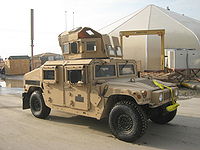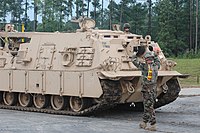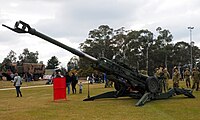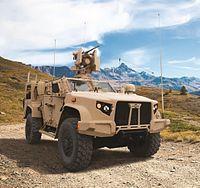Antillean Army
- Not to be confused with the Continental Army, the land warfare branch of the United Commonwealth of Continental States in the North American mainland.
| Antillean Army | |
|---|---|
 Emblem of the Antillean Army | |
| Founded |
June 3, 1784 (as the United States Army) |
| Country |
|
| Branch | Army |
| Role | Land warfare |
| Size |
289,000 Regular Army 61,330 Army National Guard 1,049,270 Army Reserve |
| Part of | Department of the Army, Columbia City |
| March | "Battle Hymn of the Republic" |
| Anniversaries | 3 June |
| Engagements | |
| Commanders | |
| Secretary of the Army |
|
| Chief of Army Staff |
|
| Vice Chief of Army Staff |
|
| Sergeant Major of the Army |
|
| Insignia | |
| Flag |
 |
| Logo |
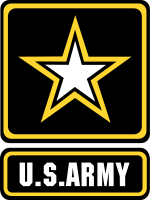 |
The Antillean Army, officially the United Commonwealth Army (UCA), or historically known as the Federalist Army, is the land warfare branch of the Antillean Armed Forces, the military of the Antilles. The modern Antillean Army was established in 1921 from the remnants of the forces loyal to the Federalist government following their defeat to the Continentalist Party during the Continental Revolutionary War and the great exodus to the island of Hispaniola. Since the end of the Revolutionary War no peace agreement has been signed with the United Commonwealth of Continentalist States that controls the mainland, making the Antillean Army the final line of defense of a possible Continental invasion of Antilles. The main focus of the Army is defending the home islands through urban warfare and siege warfare. The majority of its forces are located on Hispaniola, while the rest are based in Cuba, Puerto Rico, and the Virgin Islands.
Although it is officially unrecognized as the United Commonwealth by the League of Nations, Antilles maintains de facto relations with Sierra, Superior, Astoria, and other Conference of American States member countries. They are the main foreign suppliers of weaponry to Antilles and have helped the country develop its own local arms industry. During the Cold War the country developed close military cooperation with other CAS and NTO states, despite not being a member of those organizations, and maintains one the largest militaries in the world, especially for a country of its size. The Antillean Army regularly trains in allied countries with the Sierran Royal Army, the Superian Royal Army, and the Astorian Army, also because the high level of urbanization and population density in most of the Antillean islands means there are not enough empty spaces of land that would be suitable for large-scale exercises.
The U.C. Army is headed by the Chief of Army Staff, who exercises control of the Army on behalf of and answers to the civilian Secretary of the Army, who in turn answers directly to the President. The Army officially exists as an all volunteer force since the abolition of conscription in 1985, though National Service is still a requirement for Antillean citizens to be able to vote in elections and hold certain government jobs. Administratively, the force is organized into the Regular Army, the active duty component, along with two reserve components, the National Guard and the Army Reserve. Before 1985 there was a fourth component, the National Army, which consisted of all conscripts currently serving, but it was dissolved after the end of conscription. As of 2022, the fighting forces of the U.C. Army are organized geographically under four Area Commands, which function as military districts, for each of the provisional commonwealths (Hispaniola, Cuba, Puerto Rico, and the Virgin Islands), along with an expeditionary force for overseas deployments.
Mission
The purpose of the Antillean Army is defined as defending the territory of the United Commonwealth of America, maintaining and guaranteeing the sovereignty and independence of the country, and providing the land forces to fulfill any national objective as ordered by the Commander-in-Chief, the President of the United Commonwealth of America. The Army Strategy 2028 document, which was published in 2018 by the Department of the Army and sets out the objectives of the service over the next decade, describes the purpose of the land force as to be prepared for combined arms maneuver warfare and high-intensity conflict for the first time since the end of the Cold War. Between 2002 and 2018, it was intended for the Army to be reduced in size and have a smaller role for Antillean power projection capabilities in the Caribbean region, but since 2018 this doctrine has been revised to increase the importance of the land forces in the national defense of the Antilles. Arian Lawrence, who served as Army Secretary from 2013 and then as President from 2021, has called for a reversal of the post-Cold War reductions to the Armed Forces and has enacted policies aimed to increase the size of the Army by 2028.
History
Late 19th century
The Antillean Army, also known as the United Commonwealth Army, was created from the former United States Army after the War of Contingency in 1868. A total of 1.6 million men had served in the army during the conflict and were demobilized after it ended. The United Commonwealth Army remained relatively small from 1870 until the late 1880s, mainly used to maintain internal order and put down workers' strikes that became violent as the country industrialized rapidly during this era. As the United Commonwealth became increasingly recognized as a world power in the 1880s, the Federalist Party politicians began expanding the military. Based on the 1887 organizational plan the U.C. Army was divided into regional military departments (districts) that each covered one state, for a total of 12 districts. Four regional departments (North, Central, Atlantic, and South) were created, each overseeing several districts. During wartime, each district would form one Army infantry division, also being supported by one national guard division in each state. The Militia Act of 1888 reorganized the Army further to bring it under centralized control. The National Guard was consolidated under the central government rather than the state governments, and would be deployed along side the Regular Army. The total strength of the Army was around 110,000 by 1890.
In 1898 the United Commonwealth Army saw its first major action since the War of Contingency, against the Spanish Army during the Spanish–American War. The Caribbean campaign resulted in several decisive victories over the under-supplied Spanish forces, leading to the annexation of the Hispaniola and Puerto Rico by the United Commonwealth, and the occupation of Cuba before that country was granted its independence. In 1900, a unit of Commonwealth soldiers would also participate in quelling the Boxer Rebellion in China when the Commonwealth legation in Beijing was attacked by Chinese Boxer rebels along with other foreign legations. The United Commonwealth solidified its status as one of the great powers of the world with its involvement in those conflicts, and in the early 1900s Army troops also participated in several minor campaigns in the Central American nations, where the U.C. had economic interests. In 1907 some Army troops and Marines were deployed to Nicaragua and Honduras to prevent an outbreak of war between them.
However, increasingly in the 1910s the Army was used to put down worker revolts and strikes as political and economic unrest in the country increased. While the army used excessive methods to crack down on these strikes, more and more strikes, riots, and demonstrations by labor unions and socialist parties and organizations continued and by 1917, these groups began forming self-defense councils and militias to oppose the army and private security forces that sought to maintain the Federalist-dominated authoritarian government and these methods only caused further unrest and lead to a Landonist revolution.
Continental Revolutionary War
The United Commonwealth Regular Army numbered about 100,000 as of 1916 and was not prepared for large scale operations when the revolutionary unrest began breaking out in the eastern United Commonwealth. With the start of the Pacification Campaign of Appalachia in the fall of 1917, it saw the deployment of Regular Army soldiers of the Department of the Ohio, Department of West Virginia, Department of Virginia, Department of Kentucky, and Department of Pennsylvania, along with their respective National Guard forces, for a total of approximately 71,000 troops – more than half of the Regular Army at the time and a significant portion of the National Guard. By the time the deployment was complete to the Appalachia region the number of people involved in the "workers' insurrection" continued to grow, and protests broke out in some Midwestern cities such as Indianapolis. In December 1917, as the country was becoming overwhelmed with protests and uprisings, President Theodore Attenborough declared a general mobilization of volunteers and conscripts with the Emergency Conscription Act to bring the army to its largest levels since the American Civil War. The bill called for the implementation of the mobilization in waves for up to 500,000 troops in total, though within a year it would be increased far beyond that number. The new volunteers and conscripts were designated as the National Army, serving along side the Regular Army and the National Guard, though as the war progressed these designations became nominal as National Army, Guard, and Regular troops were combined into the same units. In the initial weeks of 1918 there was a wave of volunteers but conscription was also implemented starting in early February 1918.
By early January 1918, the Army Staff began the president's order to create a five-corps army (it consisted of five named armies but each of them was the size of a corps). In June 1918 there were 760,000 troops that had been mobilized. The structure of the Federalist Army was as follows: the Army of the Ohio, Army of the Potomac, Army of the Tennessee, Army of the Missouri, and the Army of the South.
Developments in the 1920s
Great War and reorganization
Cold War
Modern era
Command, control, organization


The Antillean Army is made up of three components, the Regular Army as the active-duty component, and two reserve components, the National Guard and the Army Reserve. When conscription was in effect between 1922 and 1985, there was also the National Army, which consisted of all conscripts that augmented the Regular Army. Together, the Regular Army, the National Army, the Army Reserve, and the National Guard formed the "Army of the United Commonwealth of America," which is the legal name of the collective land forces of the Antilles as defined by the 1983 constitution. The National Defense Reorganization Act of 1985 abolished conscription, and established the current structure of the U.C. Army into the Regular Army, the National Guard, and the Army Reserve, which currently form the Army of the United Commonwealth of America. The last Antillean conscripts left the service in 1987.
The Department of the Army is the civilian administrative agency of the branch, responsible for supply procurement, recruitment, technological development, and setting the policies of the Army in accordance with the presidential administration's broader objectives. The Army Department is headed by the civilian Secretary of the Army, who reports to the President and provides civilian oversight for the Chief of Army Staff. The Chief is the professional head of the Army and leads the Army Staff, which is a headquarters staff of officers that assist the Chief in carrying out his duties as the highest ranking officer of the force, responsible for maintaining the readiness of the Army and providing combat forces to the government to achieve operational objectives at the discretion of the commander-in-chief. The Chief of Army Staff is also assisted by a Vice Chief of Staff and by the Sergeant Major of the Army, who is the senior enlisted advisor to the Chief and is the highest-ranking enlisted soldier in the Army.
In the command hierarchy, below the Army Staff are the functional and geographic commands. The combat units of the Army are subordinated to geographic Area Commands, which replaced the former field armies and corps in 2002 that had previously been active during the Cold War. The Army Forces Command is in charge of overseeing all of the geographic commands and their units, and to provide the the Chief of Staff and the Commander-in-chief the necessary forces to carry out military operations. The other functional commands have specific supporting roles, such as training, developing doctrine, managing logistics, or providing services, such as internal policing or engineering.
Since the 2002 military reforms, field armies and most corps have been abolished in favor of Area Commands, while divisions have been turned into mostly administrative units that are there to organize the operational combat forces and provide logistical support, consisting of brigade combat teams as the basic unit. Division headquarters are structured to be able to command up to multiple brigades, including those not assigned to division, in active combat. Area Commands have jurisdiction over all U.C. ground forces in their area of responsibility, acting as theater commands in the event of war. The 1st Airborne Corps is one notable exception, as it was reactivated in 2016 as the land component of the Antillean Expeditionary Force, also known as the United Commonwealth Expeditionary Force, consisting of two divisions.
Structure
| Functional commands | Current commander | Location of headquarters |
|---|---|---|
| – |
||
| – |
||
| – |
||
| Geographic commands | Current commander | Location of headquarters |
| – |
||
| – |
||
| – |
||
| – |
||
| – |
||
| – |
||
| – |
||
| – |
||
| – |
||
| – |
||
| – |
||
Personnel

The U.C. Army consists of enlisted personnel, non-commissioned officers, and commissioned officers. Enlisted personnel hold the ranks from private to specialist, while corporals and sergeants have a leadership role and are considered non-commissioned officers (NCOs). Becoming a commissioned Army officer requires either attending the Columbia Military Academy, attending Army Officer Candidate School (OCS) for those enlisted soldiers that are also college graduates, or being directly commissioned into the Army (this is only done for specific occupations, usually medical professionals, lawyers, or chaplains). When National Service (conscription) was in effect from 1922 to 1985, there were also Army conscripts that served two- or three-year terms.
Personnel levels of the Army were maintained between 350,000 and 600,000 throughout much of the country's history. During the 1990s there was a reduction in the size of the military as the Cold War was winding down. By 2001, the total number of Army active personnel was at 327,000, at that time the lowest it had been since the retreat of the Federalist to the Antilles. As of 2022, the number is 289,000 active troops, but Army Secretary Arian Lawrence announced in 2016 that the Army must be increased back to at least 350,000 troops within a decade and maintained at those levels, given the heightened tensions with the Continentalist Mainland. This was confirmed in the Army Strategy 2028 document published by the Department of the Army in 2018. In early 2020 the Department noted that the force is significantly behind in making progress towards the goal. The Army Recruiting Command has increased its annual recruitment objectives to meet the projected force strength by 2028, and in the fall of 2022 President Lawrence and the National Assembly of the United Commonwealth authorized additional spending on recruitment efforts and bonuses to address the shortfall in the number of soldiers.
Training and occupations
Army recruits go through 8 weeks of Basic Combat Training, followed by another 8 weeks of Advanced Individual Training in their military occupation specialty (MOS). The advanced individual training for an MOS depends on the role, with the more technical MOS's requiring several months of training. For those soldiers in combat specialties, the Infantry School and the Armor School have the longest running courses. Junior officers are required to spend time serving as platoon leaders in new recruit platoons going through Basic Combat Training. The lieutenants serving as platoon leaders free up drills sergeants from having to perform administrative and logistical tasks, allowing them to spend more time training the recruits, while also giving the lieutenants effective leadership training. Officer training consists of two stages: the pre-commissioning stage of training, Officer Leadership Course A, which is either attending the Columbia Military Academy (UCMA) after high school, participating in the Reserve Officer Training Corps (ROTC) while in high school and college, or attending Army Officer Candidate School (OCS) after serving as an enlisted soldier and already having college degree; followed by Officer Leadership Course B, which is the advanced individual training for officers post-commissioning and its content varies depending on an officer's assignment and specialty. Both officers and enlisted are expected to continue to attend training events and exercises throughout the course of their career.
The Army Combat Fitness Test has been standardized for both male and female recruits and takes place over the course of one hour. Six events of the test were designed to examine endurance and strength levels that would be needed in combat actions: three deadlifts, a standing power throw of a ten-pound medicine ball, hand-release pushups (which replace the traditional pushup), a sprint/drag/carry 250 yard event, pull-ups, a mandatory rest period, and a two-mile run. All serving soldiers (Regular Army, National Guard, and Reserve) are required to pass the test.
Uniforms
There are three types of Army uniforms issued to all personnel. The Army Combat Uniform (ACU) uses the Operational Camouflage Pattern (OCP), and is worn when in the field or doing physical labor. The Army Green Service Uniform (AGSU), also known as the "Army Greens," is the daily garrison uniform that is worn by soldiers when conducting work that is not dirty or out in the field. Starting in 2019, the Army Staff has issued a directive for soldiers to wear the AGSU more often when not in training exercises or on deployment instead of always wearing the camouflage ACU. Finally there is the Army Blue Dress Uniform (ABDU), also called the "Army Blues," which is the ceremonial full dress uniform worn on special occasions such as parades and other formal events.
Between the 1960s and 2015 the force only used two uniforms, the Combat Uniform and the Army Blues. The traditional green service uniform was phased out shortly after the Vietnam War. This decision was reversed in 2015 by Army Secretary Arian Lawrence, when he announced that the Army Greens will be returning as the service uniform. The reintroduction of the Army Greens is intended to honor the nation's heritage of service in the Great Wars, to increase troop morale and recruitment numbers. The Army Blues will remain in regular optional use until 2028, when they will be completely phased out as the service uniform by the Greens and will become only a ceremonial uniform. The first Army Greens were issued to senior officers and recruiters before the end of 2015, then to other select units in 2016, and began distribution to all Army personnel at the start of 2017.
Ranks and insignia
- Officers
| Pay grade |
General officers | Senior officers | Junior officers | |||||||||
|---|---|---|---|---|---|---|---|---|---|---|---|---|
| Special grade | O-10 | O-9 | O-8 | O-7 | O-6 | O-5 | O-4 | O-3 | O-2 | O-1 | Special grade | |
Antillean Army (Edit) |
 
|

|

|

|

|

|
 
|
 
|

|

|

|
No insignia |
| General of the Armies | General of the Army | General | Lieutenant general | Major general | Colonel | Lieutenant colonel | Major | Captain | First lieutenant | Second lieutenant | Officer cadet | |
- Warrant
| Pay grade |
Warrant Officers | ||||
|---|---|---|---|---|---|
| WO1 | CWO2 | CWO3 | CWO4 | CWO5 | |
Antillean Army (Edit) |
|||||
| Warrant officer 1 | Chief warrant officer 2 | Chief warrant officer 3 | Chief warrant officer 4 | Chief warrant officer 5 | |
- Enlisted
| Pay grade |
Senior NCOs | Junior NCOs | Enlisted | ||||||
|---|---|---|---|---|---|---|---|---|---|
| OR-9 | OR-8 | OR-7 | OR-6 | OR-5 | OR-4 | OR-3 | OR-2 | OR-1 | |
Antillean Army (Edit) |

|

|

|

|

|

|

|

|
|
| Sergeant major | Master sergeant | Sergeant first class | Staff sergeant | Sergeant | Corporal | Specialist | Private first class | Private | |
Equipment
See also
Template:United Commonwealth Armed Forces
-

This page uses material from the Wikipedia page United States Army, which is released under the Creative Commons Attribution-ShareAlike 3.0 Unported License (view authors).










